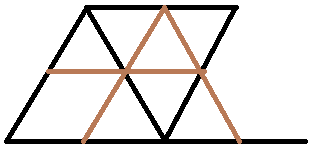The problem is as follows:
The figure from below shows 9 matches. If only 3 of them are changed from their positions, then what is the most number of triangles that can be made?
The alternatives given in my book are as follows:
- 9 triangles
- 10 triangles
- 11 triangles
- 12 triangles
- 14 triangles
I found this problem in my book Reason and Logic from 2000s under the chapter on optimization. From the style it seems to be an adaptation from a reprinted copy of Martin Gardner's 50's book of Recreational puzzles.
So far what I attempted to do is to move the three matches in the center and arrange them so that the triangle is split in half and the another half. But on counting the most triangles I could get were 9, but this doesn't check with the official answer.
Is there a strategy or method I can use to guess or try with more success to get the right answer? Can someone help me with a step by step approach and a drawing to see where to put those matches?







